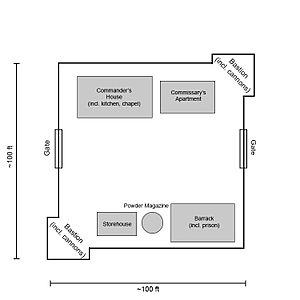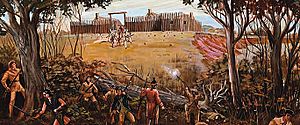Fort Carlos facts for kids
Fort San Carlos, also known as Fort Carlos, was the name for a series of forts built by the Spanish in Arkansas Post. These forts were simple wooden stockades. Their main job was to protect the trading post from attacks. The forts were named after King Charles III of Spain. He was the king when Spain owned this area (from 1763 to 1789).
The forts were very important to the post. They held the commander's house, soldier barracks, storage for supplies, and places to keep gunpowder. The first fort was about 10 miles from the mouth of the Arkansas River. The second was about 35 miles upriver. Today, the remains of these Spanish forts are underwater. This is because the riverbanks have eroded and the river's path has changed.
Fort Carlos II: The First Spanish Fort
When Spain took control of the Arkansas area in 1763, they decided to move their soldiers. They moved them from the old French settlement of Arkansas Post. The new fort, Fort Carlos II, was built by 1768. It was about 10 miles from where the Arkansas River meets the Mississippi.
A British captain named Philip Pittman visited in 1768. He described the fort as a square shape. Each side was about 108 feet long. It had small cannons in its corners. Inside, there was a barrack with three rooms for soldiers. There was also a house for the commanding officer. Other buildings included a powder magazine and a place to store food. All these buildings were in poor condition. The fort stood about 200 yards from the river. It had a captain, a lieutenant, and 30 French soldiers.
In 1777 and 1778, the Arkansas Post flooded during the spring. Captain Balthazar de Villiers was in charge. He asked the Spanish governor of Louisiana, Bernardo de Gálvez, to move the post upriver. De Villiers was worried about the yearly floods. He also noted the long distance from the local Quapaw villages, where they traded.
Governor Gálvez said yes. De Villiers was allowed to leave the site. He moved the post back to the old French settlement. This new spot was about 35 miles upriver. There is no record of Fort Carlos II being used after this move. Its remains are now believed to have been washed away by the river.
Fort Carlos III: A Stronger Defense
This fort was built in July 1781. It was at the new location of the post. Its construction began because some enemies planned to attack the post that month. Captain de Villiers wrote to Governor Gálvez on July 11. He said he planned to build a new, strong fort. He wanted it to resist any attack without cannons.
Fort Carlos III was on the north side of the river. It was about half a mile upriver from the main settlement. This new spot was on a high bluff called Grand Prairie. This meant it was above the flood plain.
De Villiers described the fort's walls, called a stockade. They were made of red oak stakes. These stakes were 13 feet high and 10 to 16 inches thick. They were split in half. Inside, they were made stronger with similar stakes. The stockade also had a two-foot-high platform for soldiers to stand on.
He also wrote that the stockade enclosed all the necessary buildings. This included a house 45 feet long and 15 feet wide. There was also a storehouse. Both of these housed his troops. Several smaller buildings were also inside.
The fort had two gates on opposite sides. It also had two bastions, which are strong, projecting parts of the fort. These were at opposite corners. Each bastion had a 3 1/2-inch brass cannon. There were openings in the stockade for the cannons and smaller swivel guns. These openings had bullet-proof sliding panels.
Lieutenant Luis de Villars became the acting commander in April 1782. This happened after Captain de Villiers became too sick to work. Captain Jacobo Dubreuil took over as commander on January 5, 1783. He added another bastion to the fort. De Villars stayed at the fort as second-in-command.
Fort Carlos III was central to the Colbert Raid in 1783. This battle happened during the American Revolutionary War. During the raid, the fort served as a safe place for local women and children.
The side of the fort closest to the river slowly broke down. This was due to erosion and flooding from 1787 to 1789. Ignacio Delinó took control of the post in 1790. He built a new fort, Fort San Estevan, about half a mile back from the river. This new fort replaced the ruined Fort Carlos. By February 1793, the old Fort Carlos site had completely eroded into the river.
When the United States bought the territory in 1803 (the Louisiana Purchase), they renamed Fort San Estevan as Fort Madison. It was abandoned after 1810. Erosion continued over time. Eventually, Fort San Estevan/Madison also disappeared into the river. Today, the remains of all these Spanish forts are underwater. They lie beneath Horseshoe Lake (Post Bend), which is an old channel of the Arkansas River now used for navigation.



